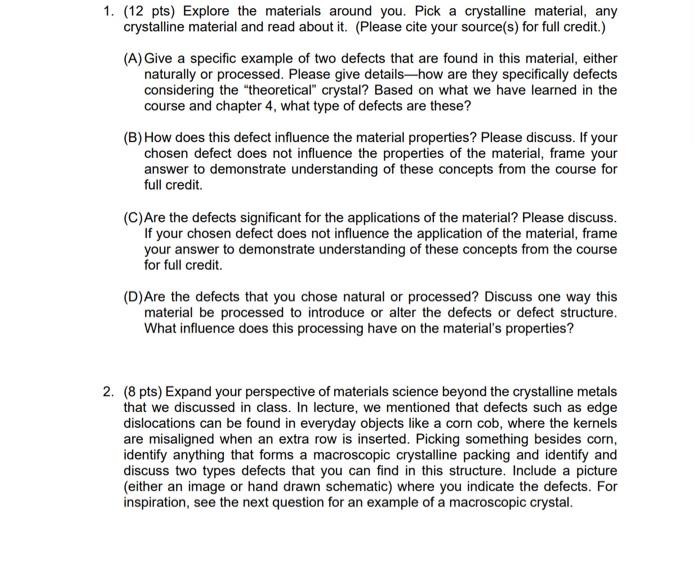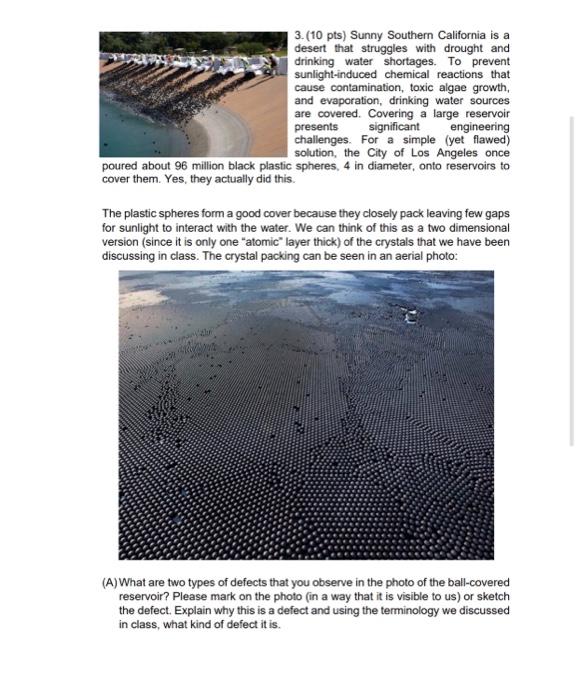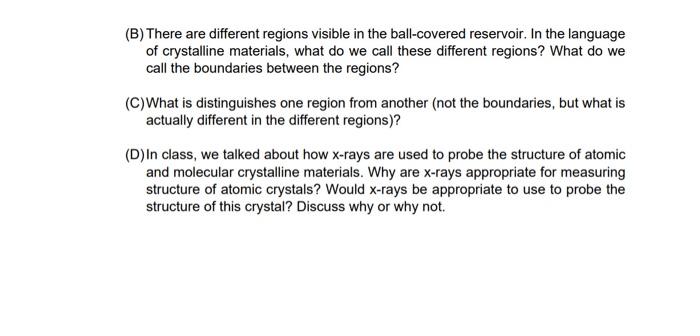Answered step by step
Verified Expert Solution
Question
1 Approved Answer
Please answer as quickly as possible 1. (12 pts) Explore the materials around you. Pick a crystalline material, any crystalline material and read about it.
Please answer as quickly as possible 


1. (12 pts) Explore the materials around you. Pick a crystalline material, any crystalline material and read about it. (Please cite your source(s) for full credit.) (A) Give a specific example of two defects that are found in this material, either naturally or processed. Please give detailshow are they specifically defects considering the theoretical" crystal? Based on what we have learned in the course and chapter 4, what type of defects are these? (B) How does this defect influence the material properties? Please discuss. If your chosen defect does not influence the properties of the material, frame your answer to demonstrate understanding of these concepts from the course for full credit. (C) Are the defects significant for the applications of the material? Please discuss. If your chosen defect does not influence the application of the material, frame your answer to demonstrate understanding of these concepts from the course for full credit (D) Are the defects that you chose natural or processed? Discuss one way this material be processed to introduce or alter the defects or defect structure. What influence does this processing have on the material's properties? 2. (8 pts) Expand your perspective of materials science beyond the crystalline metals that we discussed in class. In lecture, we mentioned that defects such as edge dislocations can be found in everyday objects like a corn cob, where the kernels are misaligned when an extra row is inserted. Picking something besides corn, identify anything that forms a macroscopic crystalline packing and identify and discuss two types defects that you can find in this structure. Include a picture (either an image or hand drawn schematic) where you indicate the defects. For inspiration, see the next question for an example of a macroscopic crystal. 3. (10 pts) Sunny Southern California is a desert that struggles with drought and drinking water shortages. To prevent sunlight-induced chemical reactions that cause contamination, toxic algae growth, and evaporation, drinking water sources are covered. Covering a large reservoir presents significant engineering challenges. For a simple yet flawed) solution, the City of Los Angeles once poured about 96 million black plastic spheres, 4 in diameter, onto reservoirs to cover them. Yes, they actually did this. The plastic spheres form a good cover because they closely pack leaving few gaps for sunlight to interact with the water. We can think of this as a two dimensional version (since it is only one "atomic" layer thick) of the crystals that we have been discussing in class. The crystal packing can be seen in an aerial photo: (A) What are two types of defects that you observe in the photo of the ball-covered reservoir? Please mark on the photo (in a way that it is visible to us) or sketch the defect. Explain why this is a defect and using the terminology we discussed in class, what kind of defect it is. (B) There are different regions visible in the ball-covered reservoir. In the language of crystalline materials, what do we call these different regions? What do we call the boundaries between the regions? (C)What is distinguishes one region from another (not the boundaries, but what is actually different in the different regions)? (D) In class, we talked about how x-rays are used to probe the structure of atomic and molecular crystalline materials. Why are x-rays appropriate for measuring structure of atomic crystals? Would x-rays be appropriate to use to probe the structure of this crystal? Discuss why or why not. 1. (12 pts) Explore the materials around you. Pick a crystalline material, any crystalline material and read about it. (Please cite your source(s) for full credit.) (A) Give a specific example of two defects that are found in this material, either naturally or processed. Please give detailshow are they specifically defects considering the theoretical" crystal? Based on what we have learned in the course and chapter 4, what type of defects are these? (B) How does this defect influence the material properties? Please discuss. If your chosen defect does not influence the properties of the material, frame your answer to demonstrate understanding of these concepts from the course for full credit. (C) Are the defects significant for the applications of the material? Please discuss. If your chosen defect does not influence the application of the material, frame your answer to demonstrate understanding of these concepts from the course for full credit (D) Are the defects that you chose natural or processed? Discuss one way this material be processed to introduce or alter the defects or defect structure. What influence does this processing have on the material's properties? 2. (8 pts) Expand your perspective of materials science beyond the crystalline metals that we discussed in class. In lecture, we mentioned that defects such as edge dislocations can be found in everyday objects like a corn cob, where the kernels are misaligned when an extra row is inserted. Picking something besides corn, identify anything that forms a macroscopic crystalline packing and identify and discuss two types defects that you can find in this structure. Include a picture (either an image or hand drawn schematic) where you indicate the defects. For inspiration, see the next question for an example of a macroscopic crystal. 3. (10 pts) Sunny Southern California is a desert that struggles with drought and drinking water shortages. To prevent sunlight-induced chemical reactions that cause contamination, toxic algae growth, and evaporation, drinking water sources are covered. Covering a large reservoir presents significant engineering challenges. For a simple yet flawed) solution, the City of Los Angeles once poured about 96 million black plastic spheres, 4 in diameter, onto reservoirs to cover them. Yes, they actually did this. The plastic spheres form a good cover because they closely pack leaving few gaps for sunlight to interact with the water. We can think of this as a two dimensional version (since it is only one "atomic" layer thick) of the crystals that we have been discussing in class. The crystal packing can be seen in an aerial photo: (A) What are two types of defects that you observe in the photo of the ball-covered reservoir? Please mark on the photo (in a way that it is visible to us) or sketch the defect. Explain why this is a defect and using the terminology we discussed in class, what kind of defect it is. (B) There are different regions visible in the ball-covered reservoir. In the language of crystalline materials, what do we call these different regions? What do we call the boundaries between the regions? (C)What is distinguishes one region from another (not the boundaries, but what is actually different in the different regions)? (D) In class, we talked about how x-rays are used to probe the structure of atomic and molecular crystalline materials. Why are x-rays appropriate for measuring structure of atomic crystals? Would x-rays be appropriate to use to probe the structure of this crystal? Discuss why or why not 


Step by Step Solution
There are 3 Steps involved in it
Step: 1

Get Instant Access to Expert-Tailored Solutions
See step-by-step solutions with expert insights and AI powered tools for academic success
Step: 2

Step: 3

Ace Your Homework with AI
Get the answers you need in no time with our AI-driven, step-by-step assistance
Get Started


